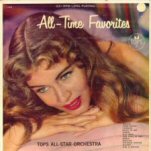
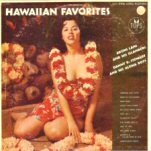
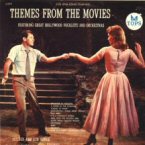
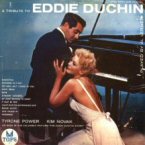
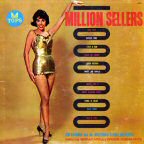
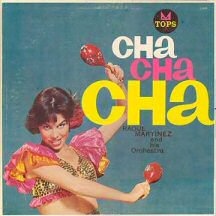
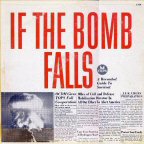
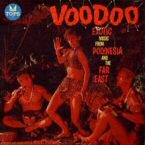
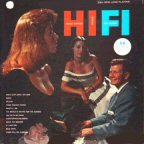
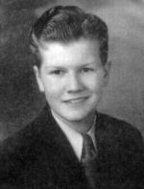
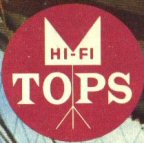 Tops/Mayfair Story
Tops/Mayfair StoryTops Records was incorporated as Tops Music Enterprises in Los Angeles, California, in 1947. Early
staff included Carl Doshay (President), Sam Dickerman (Vice President), Corky Carpenter (A&R), and
Harold Spina (A&R). Later, Dave Pell became a prolific producer for the label.
Tops Records started business in 1947, when they were located at 4418 S. Hoover St. in Los
Angeles. According to Carl Doshay, the founder, they first did business by selling used jukebox singles
in grocery and other stores. By 1949, they had moved to 4705 S. Vermont Ave. in LA.
Tops singles catalog (on both 78 and 45) featured many "soundalike" versions of current hits. A young
Lou Reed, later of the Velvet Underground and solo fame, is said to be one of the singers. The Tops
album catalog was mostly generic music to be sold cheaply to any non-discerning buyer, whether it be in
a record store or from a grocery store rack (Tops was known as one of the country's biggest "rack
jobbers," along with Pickwick.). Most artists were LA-based studio musicians, so Tops could make the
records without much overhead and sell them at "bargain" prices of 39 cents per single, 69 cents per 10"
album and $1.98 per 12" album. What "name artists" Tops did record, such as Lena Horne, the Ink
Spots, Beatrice Kay, Mel Tormé, and Meade "Lux" Lewis, were not exactly current hit makers at
that time.
Carl Doshay, the founder of Tops Records, wrote to us and sent the following synopsis of the Tops
Record Company:
A Brief History of TOPS Records, 1947 to 1960
In the Spring of 1947, Carl Doshay and his long time buddy, Sam Dickerman, left New York for Los
Angeles to seek new careers. Carl had just sold his interest in a successful wholesale watch repair
company, and wanted to resettle in the golden land of California. He was married with two young
children, leaving his family in New York until he had resettled. Sam Dickerman was a cutter in the
garment trade, and was seeking bigger opportunities.
In Los Angeles, the pair decided to start a new enterprise; selling used records to the public through
grocery markets, drug stores, five and dime stores, etc. They purchased their records from juke box
operators at from 5 to 10 cents apiece, then resold them to the public at 29 cents apiece, leaving a
handsome margin for Tops, as well as the merchants. All the records were sold on a "guaranteed sale"
basis, meaning the storekeeper would only pay for those records actually sold. This method of doing
business was originated by Tops and remained their "modus operandi" for all the coming years. In later
years, all the major record companies adopted this sales practice to compete.
Tops Music Enterprises prospered, buying and selling millions of records from Coast to Coast, to
National and Regional retailers, such as Woolworth, Thrifty Drugs, Sprouse Reitz, etc. A second
warehouse was set up in New York under the guidance of Sam Dickerman to accommodate and
facilitate the ever increasing business.
Sometime during the early fifties, it occurred to Doshay, with their enormous distribution facilities, to start
their own record label, Tops. Naturally, it would be price oriented to compete with the Major record labels
— Columbia, Decca, RCA, and Capitol. And since they had no famous singers of their own, they would
do "knock offs" of the big hits of the day. Also, the Major companies would usually have a "hit" on one
side of the shellac 78 RPM records of the day, and a "B" side, with a less desirable song, on the other.
Tops took advantage of this, promoting their product as "two hits" on every record, and for only 39 cents
to 49 cents, as opposed to the 79 cents for the Major labels.
The new TOPS records took off like gangbusters, and soon this phase of their business had become the
major source of the company's income. Doshay was spending many nights at a small recording studio in
Long Beach, supervising the non-union bands and the sound-alike singers for sessions that lasted well
into the wee hours, to keep up with the constant flow of new "hits" to reach the market. Tops sold off
their remaining used record business to a competitor, who had evolved after their success, and
concentrated on creating a National presence for their Tops label.
The operation soon became completely vertical; Tops opened their own pressing plants to manufacture
the records, first one on Figueroa, then later, the largest such plant at the time, on Normandie, in Los
Angeles. They printed their own record labels; made their shellac (and later, vinyl) at another plant in
Gardena. In later years, Tops made their own jackets for albums at the Normandie plant; adding an art
department to design covers for their albums. It was now an integrated operation, enabling Tops to
manufacture and sell records at their low prices.
At this time, they were approached by a record store owner in Chicago named Tony Galgano, to
produce a "package" of 8 latest hits on 4 records, to be marketed over the radio for $2.98. It was an
instantaneous success; the Tops plant and other pressing plants in the Los Angeles area were kept
running 24 hours a day to keep up with the demand. But the success overwhelmed the financial
resources of Galgano, and Tops was forced to cut back production. Doshay decided to emulate this
novel marketing method and hired Ted Wilson of Jack Benny fame, to do their radio commercials.
Instead of 8 hits in the package, though, Doshay conceived the idea of making an "extended play"
78RPM record, with 2 hits on each side, and after considerable experimentation in the recording studios,
proved it's feasibility. Now they were able to market 16 hits, on 4 records, in the package, for only $ 2.98.
Needless to say, this also was hugely successful; the only problems were the excessive breakage of the
fragile shellac records, and the large volume of complaints about the deception of the actual artists on
the records.
In the mid-fifties, with the advent of 45 and 33 RPM records, Tops redesigned their operation, now
leaning to using "name" artists on their albums, many of whom had passed their glory days, and other
newcomers, such as John Williams and Andre Previn. Doshay was too busy now to personally supervise
all the many recording sessions, and hired Dave Pell to assist him in recruiting artists, and producing the
sessions, although Doshay kept tight control over all of the process. With the advent of stereo in the mid
fifties, all of the recording sessions were done with this process.
In 1957, Tops was approached by a Los Angeles group of investors, who were interested in purchasing
the company, and offered $400,000. This seemed a princely sum to Sam Dickerman, who was quite
conservative, and couldn't handle the many pressures of their ever growing business. Doshay did not
want to sell, and agreed to buy Dickerman's 50% interest for $200,000. Dickerman retired, and never
worked another day in his life, living well off his accumulated savings. The two partners remained good
friends until Dickerman's death in 2000.
Tops had become quite profitable, and sought a merger partner to alleviate the heavy tax burden. Their
accountant proposed PRI, or Precision Radiation Instruments, which was the premier company
producing Geiger counters. PRI had a $2,000,000 tax loss carry forward from operating losses, due to
the bust in demand for their product. Leslie Norman, the CEO of PRI, had foreseen the uranium boom of
the late 1940s, when a prospector named Charlie Steen discovered and developed a uranium mine in
Utah and became an instant cult figure after selling his mine for millions. Thousand across the country
sought to emulate him and became week-end prospectors. They all needed Geiger counters for their
search, and PRI supplied the demand, becoming a public stock company, whose stock zoomed from
pennies to $10 per share. When the boom deflated, the stock became worthless. Norman sought to
continue operations and acquired Radio Craftsman, an old line manufacturer of high fidelity radios and
players. Even after acquiring Radio Craftsman, PRI was still losing money. But, it was a natural tie in
with Tops.
Doshay made the deal with PRI in 1958, and gradually combined operations and weaned PRI's
inventory of instruments down, which was still unprofitable. New forms of music rendition were
emerging; 4 and 8 track tapes; reel to reel tapes, and Tops kept up with the trend. An office and
warehouse had been opened in Chicago to facilitate operations in the Midwest, but closed down after
several years, due to excessive pilferage and stealing by employees.
Also in 1958, Tops hired a PR man named Bob Blythe. Bob was well connected with important business
figures across the country. He was the original maker of ball point pens under the label of BB Pens, but
eventually ran the company into the ground with excessive spending on entertainment and poor
business controls. Blythe had ambitions of taking over Tops, and approached Doshay for a price. During
1959, Doshay had suffered a heart attack, and in view of high stress activities, decided he would sell, for
one million dollars.
In the late 1950s, Tops' only major competition was Pickwick Records, who had scored a major success
with their series of "100 String Orchestra" albums. Doshay, naturally, followed suit, but also conceived of
setting up a new series of tribute albums to the "big bands", such as Glen Miller and Benny Goodman.
He sent Dave Pell to England to record them there, in view of the lower costs. These were to be issued
under a higher priced series, and under the all-stereo Mayfair label. There were also negotiations with
Frank Sinatra, but these were not fruitful, since Sinatra wanted half the company's stock for these rights.
Sinatra was at that time still dreaming of starting his own label, which he eventually did with Reprise
Records.
All planning came to a halt in 1960, when Blythe brought a purchase offer for Doshay's price, from Al
Bloomingdale and several other investors. Blythe took control of the company, and pursued policies
adverse to Doshay's recommendations. Doshay's consultant contract was terminated. In a few short
years, despite the deep pockets of Bloomingdale, Tops was bankrupt; it's major asset, the huge library
of recordings, was sold to Pickwick. After retiring for 10 years, Doshay resumed activities in the real
estate field, moving to Oklahoma in 1975 and becoming a Realtor there. He retired permanently in
1991.
Carl Doshay also forwarded us an AP story that ran nationwide in 1957,
covering some of the same history with a few more details.
Some time before the beginning of 1959, Tops moved to the same address (5810 S. Normandie Ave.,
Los Angeles) where the Bihari Brothers later operated Crown/Modern Records. Although we have no
information about what the relationship was between the two companies other than the shared address,
it is obvious that Crown was using the same printer and pressing plant originally used (owned?) by Tops,
and some masters showed up on both labels (although not always attributed to the same artists).
As late as 1962, Tops still indicated on their products that they were a subsidiary of P.R.I. This
continued until the mid-1960s, when Tops' now-parent company, Pickwick, apparently discontinued
operations of Tops as such and spun off GoldenTone, Evon, and other labels that endlessly reissued the
Tops masters.

|

|
As are many budget labels, Tops is notorious for their "cheesecake" album covers (anything to sell the records!). |

|

|
Interestingly, some of the Tops albums today are more collectable for their covers than the music inside. Jayne Mansfield was featured on at least two covers, as was Kim Novak. Rita Hayworth, Glenn Ford, William Holden, David Niven, Jack Benny, and Tyrone Power appeared at least once. Apparently, the owners of Tops had some connections with the studios in Hollywood, since photos from movies like those at left showed up regularly as Tops covers. |

|

|
And that doesn't include the "up and coming" Hollywood hopefuls of the day. Mary Tyler Moore, in her days before she became a television star, modeled for several covers. |

|

|
Certainly one of the strangest, not to mention most ironic (given the company's "Precision Radiation Instruments" name), was the 1961 album If the Bomb Falls. This little gem was a complete recorded guide on how to survive nuclear war. In the general national paranoia about nuclear war in the late 1950s and early 1960s, this was a shameless attempt to cash in on that fear, but never let it be said that American entrepreneurs couldn't find a new angle. Dave Pell, who worked at Tops as the A&R man and producer, as well as a performer, also worked as the cover photographer! He teamed up with Robert Drasnin in 1959 on an "exotica" album called Voodoo that is very collectable today. |

|

|
And as long as we're on the topic of strange, there were also two Tops albums by Billy Tipton, a jazz musician who specialized in saxophone and piano and had been leading the Billy Tipton Trio for years. As it eventually became known, Tipton was actually a woman (Dorothy Lucile Tipton) masquerading as a man. Although "he" had three adopted children and had been "married" five times, the secret of Tipton's gender was not generally known until after Tipton's death. |
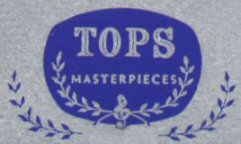 On to the Tops Album Discography, Part 1 10-inch
Albums
On to the Tops Album Discography, Part 1 10-inch
Albums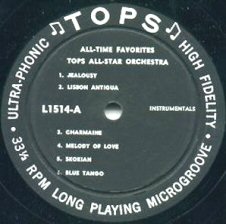 On to the Tops/Mayfair Album Discography, Part 2 12" Albums Tops
L1500-1599 (mono) and Mayfair 9500/9599S (stereo)
On to the Tops/Mayfair Album Discography, Part 2 12" Albums Tops
L1500-1599 (mono) and Mayfair 9500/9599S (stereo)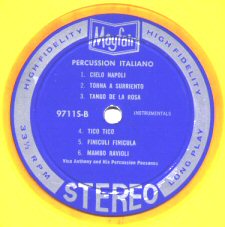 On to the Tops/Mayfair Album Discography, Part 3 12" Albums Tops
L1600-1699 (mono) and Mayfair 9600/9699S (stereo)
On to the Tops/Mayfair Album Discography, Part 3 12" Albums Tops
L1600-1699 (mono) and Mayfair 9600/9699S (stereo)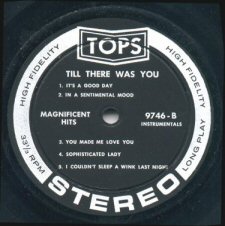 On to the Tops/Mayfair Album Discography, Part 4 12" Albums Tops
L1700-1742 (mono) and Mayfair 9700/9742S (stereo); Tops 9743-9766 (stereo)
On to the Tops/Mayfair Album Discography, Part 4 12" Albums Tops
L1700-1742 (mono) and Mayfair 9700/9742S (stereo); Tops 9743-9766 (stereo)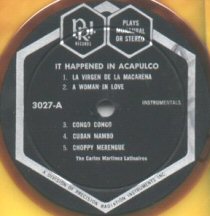 Back to the Precision Radiation Instruments (PRI) Story
Back to the Precision Radiation Instruments (PRI) Story
 Back to the Discography Listings Page
Back to the Discography Listings Page  Back to the Both Sides Now Home Page
Back to the Both Sides Now Home Page